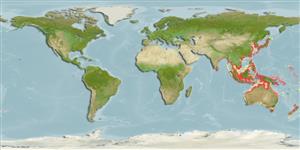Common names from other countries
Environment: milieu / climate zone / depth range / distribution range
Écologie
Benthopélagique; profondeur 0 - 50 m (Ref. 125642). Tropical, preferred 24°C (Ref. 107945)
Distribution
Pays | Zones FAO | Écosystèmes | Occurrences | Introductions
Indo-West Pacific.
Length at first maturity / Taille / Poids / Âge
Maturity: Lm 13.1 range ? - ? cm Max length : 15.9 cm CW mâle / non sexé; (Ref. 125642)
Description synthétique
Morphologie
Carapace tough to granulose, regions discernible; front with 3 acutely triangular teeth; 9 teeth on each anterolateral margin, the last tooth much larger than preceding teeth. Larger chela with conical tooth at base of fingers; pollex ridged. Color: carapace dull green to brown.
Minimum depth assumed from its ecology. Shallow waters up to depths of 50 m. Inhabits sandy to sandy-muddy substrates (Ref. 343). Benthopelagic predator, feeding mainly on bivalves (Lamellibranchia), benthic crustaceans, fishes and cephalopods (Ref. 117071).
Life cycle and mating behavior
Maturité | Reproduction | Frai | Œufs | Fécondité | Larves
Members of the order Decapoda are mostly gonochoric. Mating behavior: Precopulatory courtship ritual is common (through olfactory and tactile cues); usually indirect sperm transfer.
Ng, P.K.L. 1998. (Ref. 343)
Statut dans la liste rouge de l'IUCN (Ref. 130435)
statut CITES (Ref. 108899)
Not Evaluated
Not Evaluated
Menace pour l'homme
Harmless
Utilisations par l'homme
Pêcheries: commercial
FAO - Aquaculture: production; pêcheries: landings, species profile | FishSource | Sea Around Us
Outils
Sources Internet
Estimates based on models
Preferred temperature
(Ref.
115969): 13.8 - 29.1, mean 28 (based on 1586 cells).
Résilience
Haut, temps minimum de doublement de population inférieur à 15 mois (K=0.44-1.76).
Prior r = 1.19, 95% CL = 0.79 - 1.79, Based on 2 data-limited stock assessments.
Vulnérabilité
Low vulnerability (10 of 100).
